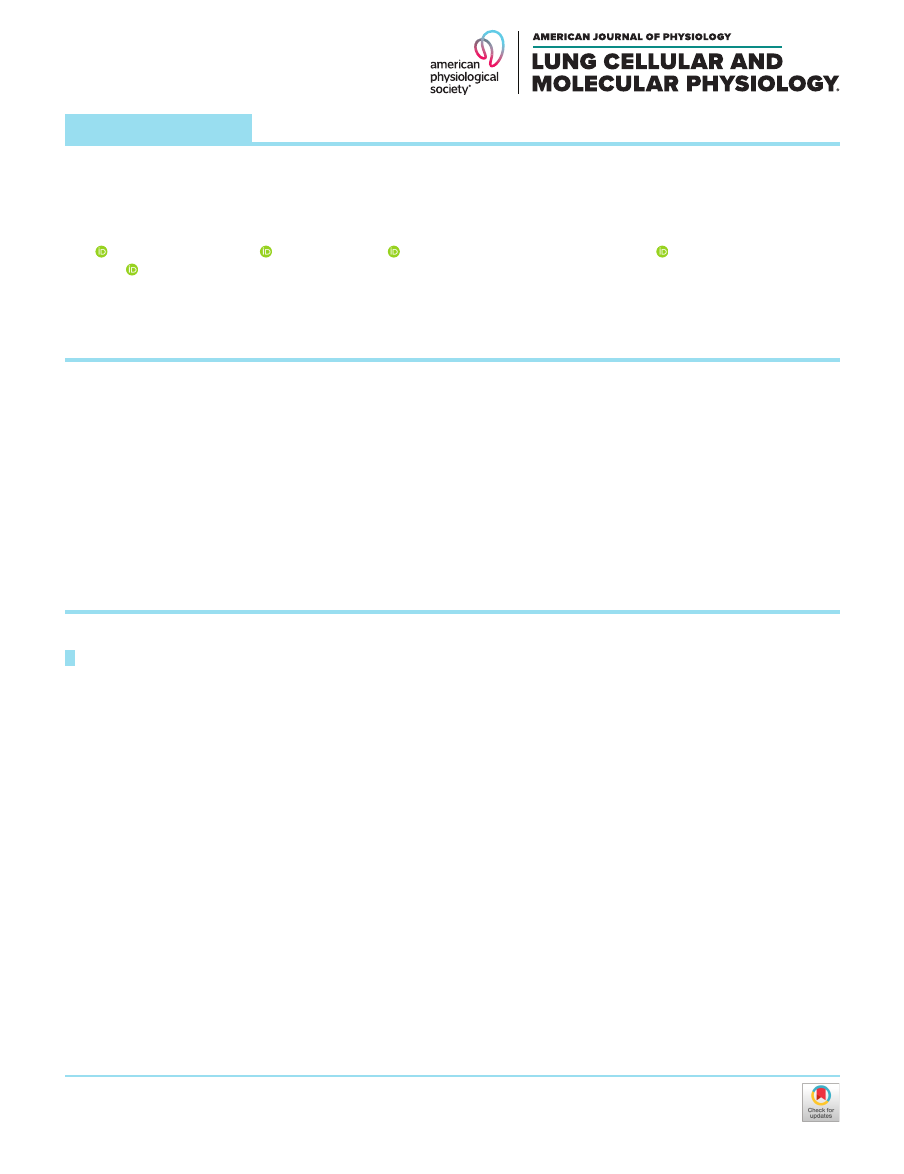
RESEARCH ARTICLE
The matricellular protein CCN3 supports lung endothelial homeostasis and
function
Giovanni Ligresti,
2
and
1
Department of Physiology and Biomedical Engineering, Mayo Clinic, Rochester, Minnesota and
2
Department of Medicine,
Boston University School of Medicine, Boston, Massachusetts
Abstract
Aberrant vascular remodeling contributes to the progression of many aging-associated diseases, including idiopathic pulmonary
fi
brosis (IPF), where heterogeneous capillary density, endothelial transcriptional alterations, and increased vascular permeability
correlate with poor disease outcomes. Thus, identifying disease-driving mechanisms in the pulmonary vasculature may be a
promising strategy to limit IPF progression. Here, we identi
fi
ed
Ccn3
as an endothelial-derived factor that is upregulated in
resolving but not in persistent lung
fi
brosis in mice, and whose function is critical for vascular homeostasis and repair. Loss and
gain of function experiments were carried out to test the role of CCN3 in lung microvascular endothelial function in vitro through
RNAi and the addition of recombinant human CCN3 protein, respectively. Endothelial migration, permeability, proliferation, and
in vitro angiogenesis were tested in cultured human lung microvascular endothelial cells (ECs). Loss of CCN3 in lung ECs
resulted in transcriptional alterations along with impaired wound-healing responses, in vitro angiogenesis, barrier integrity as
well as an increased pro
fi
brotic activity through paracrine signals, whereas the addition of recombinant CCN3 augmented endo-
thelial function. Altogether, our results demonstrate that the matricellular protein CCN3 plays an important role in lung endothe-
lial function and could serve as a promising therapeutic target to facilitate vascular repair and promote lung
fi
brosis resolution.
CCN3; IPF; lung homeostasis; pulmonary
fi
brosis; pulmonary vasculature
INTRODUCTION
Vascular regeneration is critical to wound-healing responses
and tissue repair (
), and deteriorates with aging (
). Impaired
vascular regeneration affects organ physiology (
), and has
been associated with poor outcomes in aging-associated disor-
ders, including idiopathic pulmonary
fi
brosis (IPF) (
).
IPF is a chronic, progressive, and fatal lung disease char-
acterized by aberrant wound healing, exaggerated deposi-
tion of extracellular matrix (ECM) by persistently activated
fi
broblasts (myo
fi
broblasts) (
), and several vascular
abnormalities. Among the latter, studies reported capillary
rarefaction, vascular leakage, and endothelial transcrip-
tional alterations (
,
), including limited expres-
sion of gene markers of lung endothelial progenitor cells
(also known as general capillary ECs, gCap ECs) (
). Current
therapeutic options are only able to slow disease progres-
sion, thus the prognosis is still poor, and the median sur-
vival is only 3
–
5 yr after diagnosis (
). Although most
studies have focused on nonvascular cell types as central
players of the disease, as well as preferred therapeutic tar-
gets for IPF, recent evidence shed light on the important
contribution of the pulmonary vasculature in orchestrating
wound-healing responses after lung injury (
). This
highlights an opportunity for new endothelial-focused ther-
apeutic strategies.
Using a mouse model of bleomycin-induced lung
fi
brosis,
we have recently demonstrated that the pulmonary vascula-
ture of young and aged mice displays divergent behaviors
upon bleomycin injury, with aged animals exhibiting abnor-
mal epigenetic and transcriptional responses, resulting in
aberrant lung
fi
brosis resolution (
To untangle the mechanistic underpinnings behind this
divergent vascular response, we have recently performed
RNA sequencing (RNA-seq) analysis on freshly sorted lung
ECs from the lungs of young and aged mice following the
bleomycin challenge (
). This analysis led to the identi
fi
ca-
tion of
Ccn3
, a gene encoding for the matricellular protein
Cellular Communication Network Factor 3, also known as
nephroblastoma overexpressed (Nov).
Ccn3
was upregulated
in young lung ECs in response to bleomycin injury, but not in
aged lung ECs under the same experimental conditions (
CCN3 is a secreted matricellular protein of the CCN fam-
ily that also includes CCN1 (CYR61), CCN2 (encoding con-
nective tissue growth factor, CTGF), CCN4 (WISP-1), CCN5
(WISP-2), and CCN6 (WISP-3) (
). These proteins are a
subset of ECM proteins that serve regulatory roles in
response to extracellular stimuli rather than structural roles
Correspondence: N. Caporarello (caporarello.nunzia@mayo.edu).
Submitted 4 August 2022 / Revised 23 November 2022 / Accepted 19 December 2022
L154
1040-0605/23 Copyright
©
2023 the American Physiological Society.
Am J Physiol Lung Cell Mol Physiol
324: L154
–
L168, 2023.
First published December 27, 2022; doi:
Downloaded from journals.physiology.org/journal/ajplung at UC San Diego Lib (137.110.033.005) on April 22, 2024.